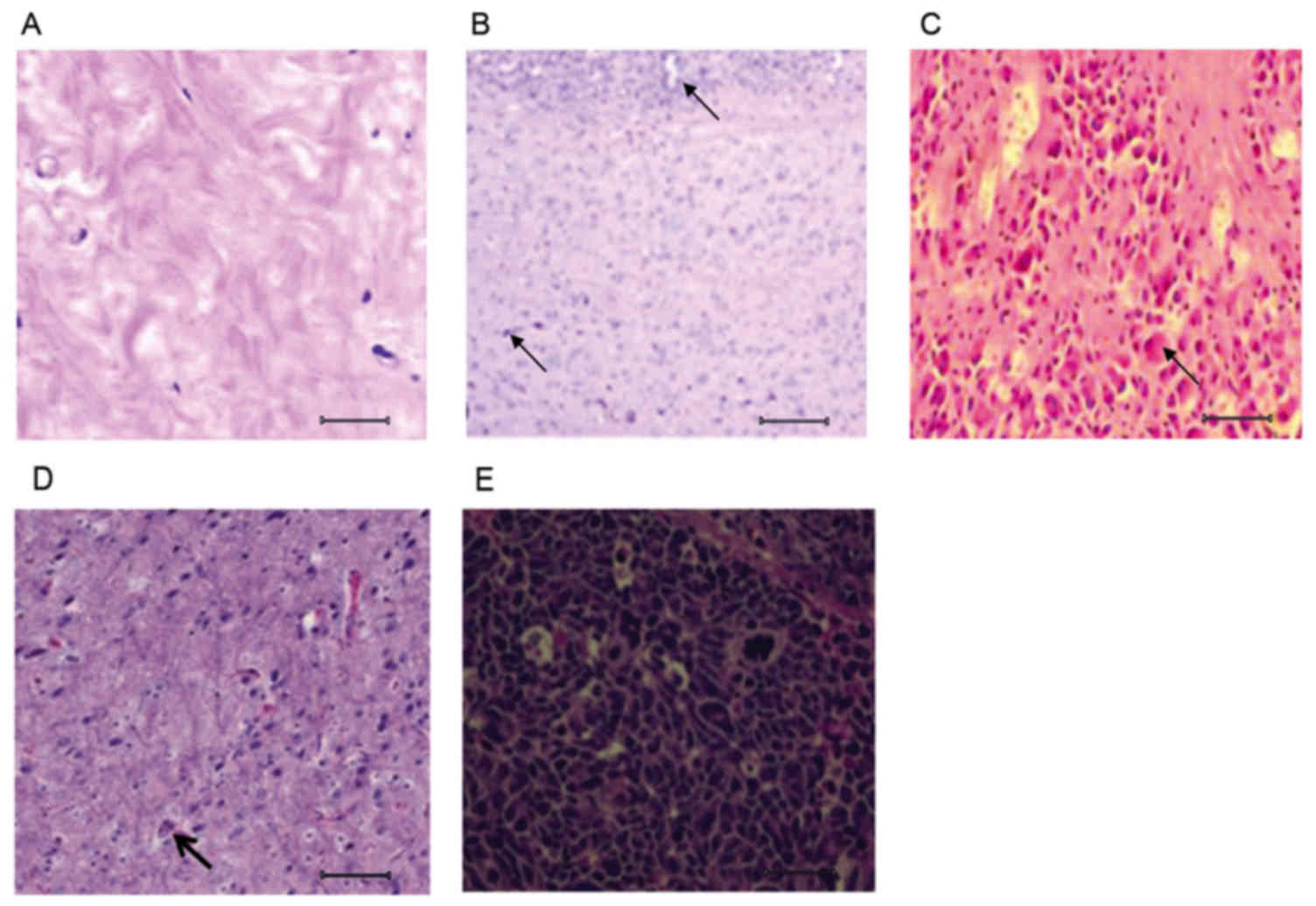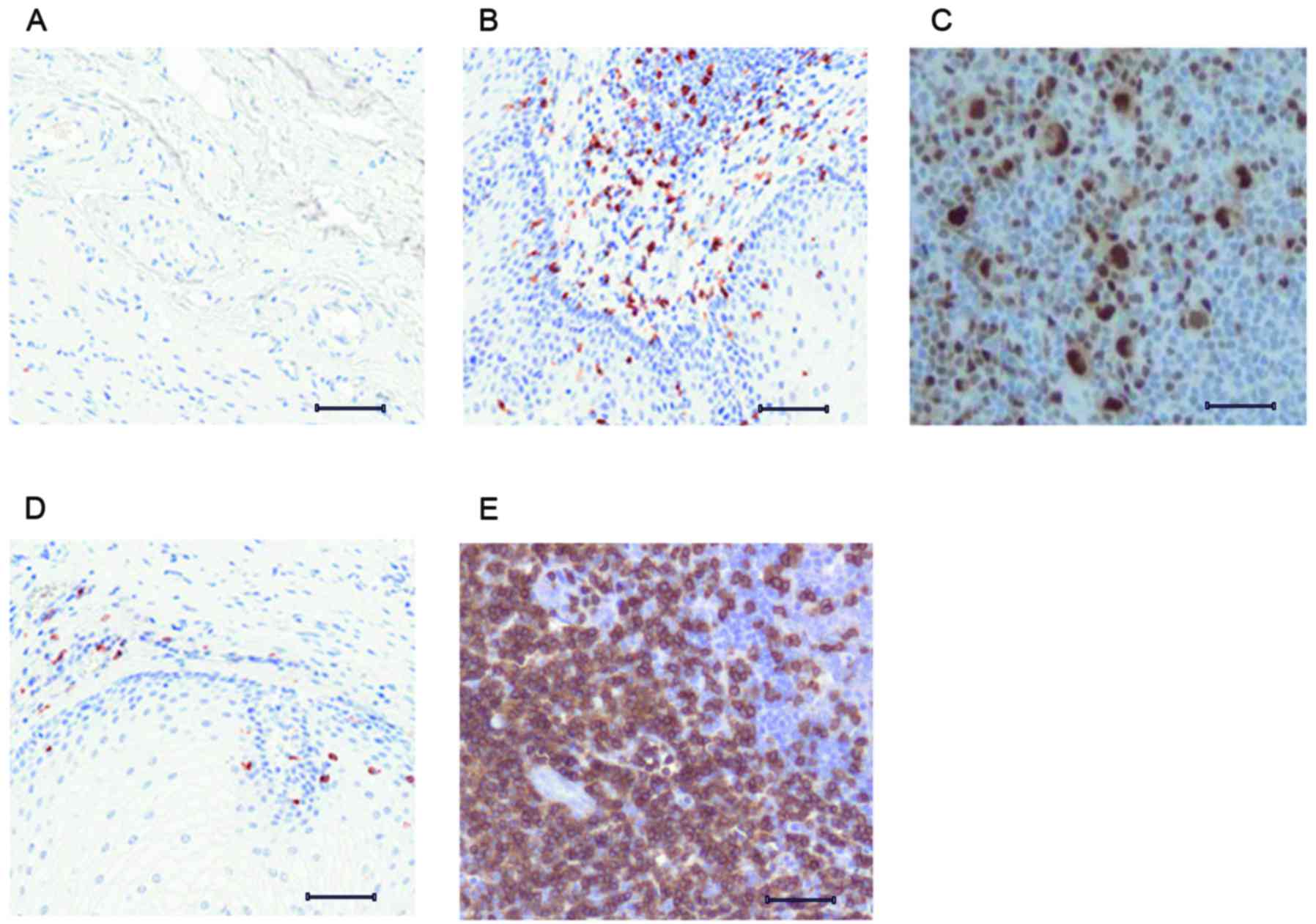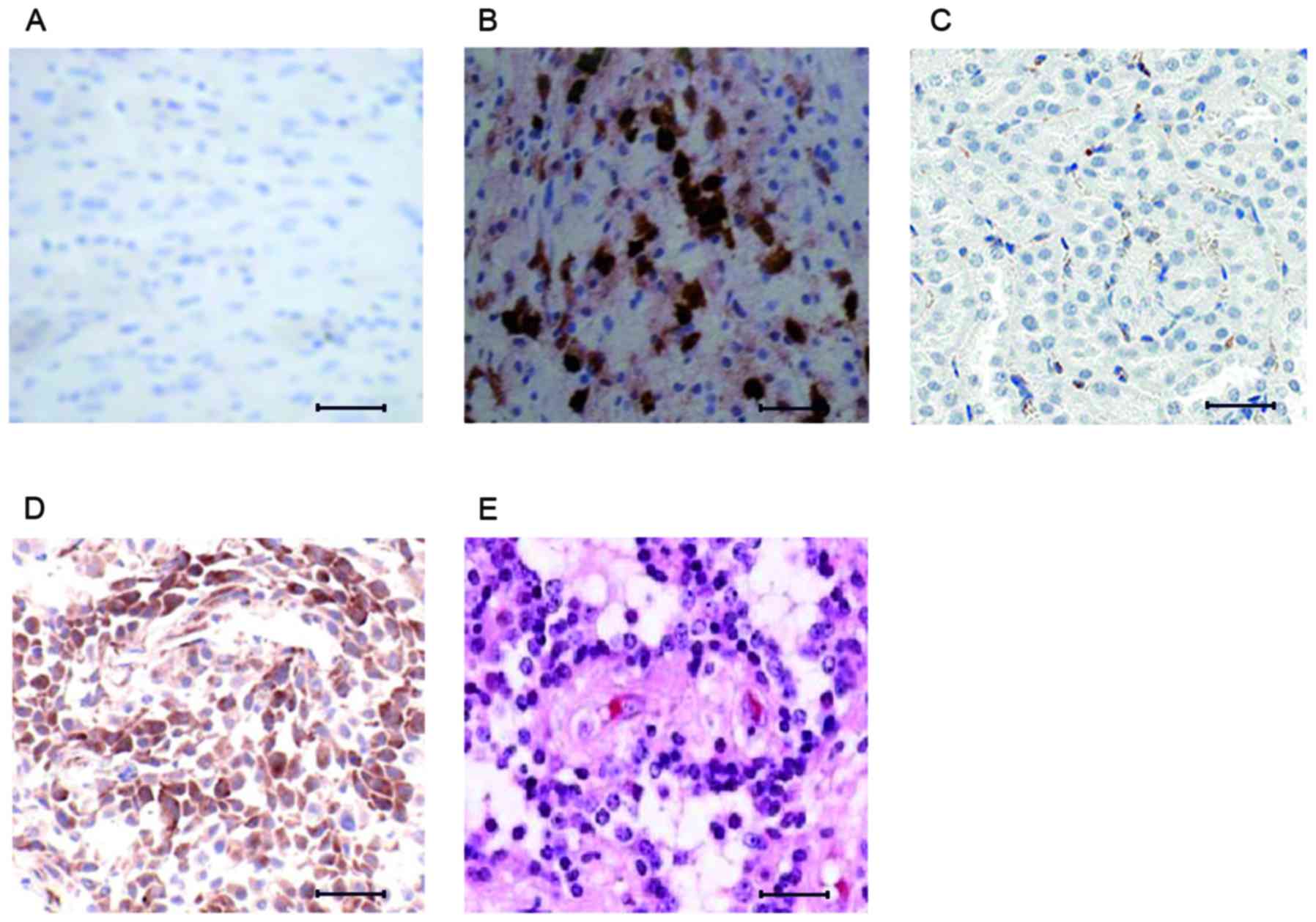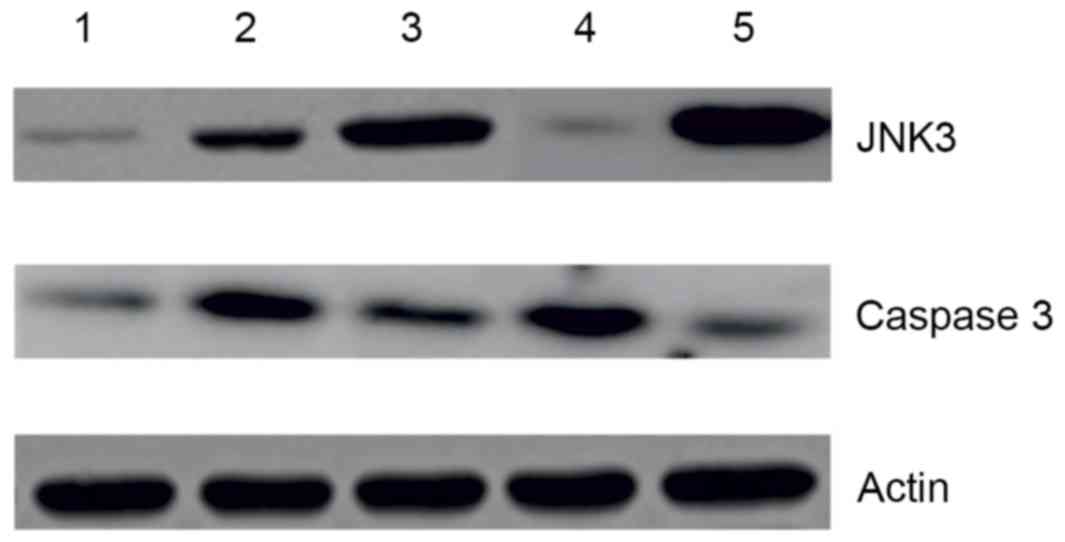c‑Jun N‑terminal kinase 3 signalling serves a potential role as a biomarker for determining the pathogenesis of Parkinson's disease
- Authors:
- Published online on: December 11, 2017 https://doi.org/10.3892/mmr.2017.8244
- Pages: 3255-3259
Abstract
Introduction
Parkinson's disease (PD) is a slow-progressing neurological disease that results in degeneration of nerve cells (1). As a result, the majority of patients exhibit signs of dementia in the earlier stages (2), and when the disease progresses they start to exhibit clinical symptoms including tremor, bradykinesia, positional imbalance and rigidity (3). Ageing is a key factor in the development of PD, as it results in morphological and neurochemical alterations in dopamine-producing neurons (4–6). Treating PD in earlier stages has a neuroprotective role in preventing or prolonging the development of disease complications (7). Treatment at later stages of PD currently has no effect, and in most cases it results in treatment resistance (1).
Earlier detection of PD is essential in the clinical management of PD. Physiological symptoms occur following neural degeneration, and thus, suitable biomarkers that detect earlier stages of PD need to be identified (8). Currently available biomarkers fail to specifically identify PD; further complications include variation within individual results and a lack of experimental reproducibility (8–10). To identify an effective biomarker it is helpful to understand the pathogenesis of PD development; however, the underlying mechanism underlying the neural degeneration of PD and its associated neural dysfunction remain to be clearly elucidated (1). An improvement in the basic knowledge of this disease is required to improve understanding of its pathogenesis, and to aid in the identification and validation of biomarkers associated with different pathological stages.
C-Jun N-terminal kinase 3 (JNK3) is markedly expressed in brain tissue (11) and has demonstrated roles in inflammation, apoptosis, cellular proliferation and neural degeneration (12,13). The present study used PD mouse models to investigate the role of apoptosis and JNK3 in PD, and how they associate with different two pathological stages of this disease.
Materials and methods
Mouse model with PD
Initially, 30 BALB/c male mice (age, 6 weeks; weight, 30–40 mg) were purchased from The Jackson Laboratory (Bar Harbor, ME, USA) were used in the present study. Mice were treated twice daily with MPTP and maintained under a 12 h light/dark cycle at 25±1°C with 45±5% relative humidity and food and water provided freely. The PD mouse model was developed using 1-methyl-4-phenyl-1,2,3,6-tetrahydropyridine (MPTP), which was directly administered into the nasal cavity of the mice at a dosage of 1.5 mg/nostril (total dose, 60 mg/kg) (14). Following treatment with MPTP, the mice displayed early symptoms of PD by the 2nd week, including hind limb weakness and restricted movements. On the 4th week, mice exhibited advanced symptoms of PD with two hind limb paralyses. Limb weakness was used to assess the development of Parkinson's disease (15). The animals, chemical used and the experimental methods for developing the PD model were approved by the animal care board of The First People's Hospital of Shangqiu (Shangqiu, China).
Treatment with rasagiline
The mice were divided into the following experimental groups (n=6/group): Normal (untreated); PD early; PD advanced; PD early + rasagline; PD advanced + rasagline. Mice with early and advanced PD were treated with rasagiline by dissolving the drug in water and administering orally at a dose of 1 mg/day (30 mg/kg), for one week. Water was used as a vehicle control. Following treatment, the clinical symptoms including limb movement and brain histological variation of the mice were analysed. The mice were subsequently sacrificed and whole brain samples were removed for further investigation.
Histology and immunohistochemistry
Brain samples obtained from early and advanced stages of PD and samples from untreated mice were sectioned into smaller pieces, fixed with 10% formaldehyde and embedded in paraffin. Formalin-fixed paraffin embedded tissue samples were subjected to histological and immunohistochemical analysis (16). Using a microtome, tissue samples were evenly sliced into 5 µm sections and placed on a slide warming table. Following deparrafinization and rehydration, the slides were stained with haematoxylin and eosin for histopathological analysis. For immunohistochemistry, the endogenous peroxidise activity was blocked using 10% H2O2 and nonspecific binding was blocked in 4% bovine serum albumin (BSA; Sigma-Aldrich; Merck KgaA, Darmstadt, Germany) solution for 1 h. The tissue sections were incubated with an anti-JNK3 antibody (cat. no. ab126591; Abcam, Cambridge, UK; 1:500) or with an anti-caspase-3 antibody that specifically detects cells with early apoptosis (cat. no. ab13847, Abcam; 1:500) overnight at 4°C. Following washing with PBS twice to reduce non-specific binding of the primary antibody, the tissues sections were incubated with a polyclonal goat anti-rabbit IgG horseradish peroxidase-conjugated secondary antibody (ab6721, Abcam; 1:5,000) for 1 h at room temperature. The slides were then washed and developed using diaminobenzidine solution and counterstained with haematoxylin and eosin. The experiments were repeated three times and the signals obtained were examined and documented under a light microscope equipped with NIS-Elements Viewer 4.3 (Nikon, Corporation, Tokyo, Japan).
Western blot analysis
To analyse the differential expression of JNK3 in samples obtained from control, and PD treated and untreated mice, western blot analysis was performed. The samples were dissected out and crushed on ice along with 2X sample buffer [500 mM Tris (pH 6.8), 20% glycerol, 4% SDS, 5% β-mercaptoethanol, 0.1% bromophenol blue], then the tube are heated in a boiling water bath for 5 min to obtain the protein lysate. The extracted protein samples were measured using the Lowry method and 70 µg/well was separated by 10% SDS-PAGE according to a previously described protocol (17). Separated proteins were transferred to polyvinyl difluoridene membranes, and the membranes were blocked with 4% BSA solution to limit non-specific binding of the antibody. Membranes were subsequently incubated with an anti-JNK3 primary antibody (cat. no. ab126591, Abcam; 1:500) or an anti-caspase-3 antibody (cat. no. ab13847, Abcam; 1:500) overnight at 4°C. Actin (cat. no. ab3280, Abcam; 1:500) served as a loading control. Following incubation, the membrane was washed three times with TBS-Tween 20 (TBST) buffer and incubated with a goat anti-rabbit IgG alkaline phosphatase-conjugated secondary antibody (Abcam, ab97048; 1:5,000) for 1 h at room temperature. The membrane was subsequently washed in TBST and developed with 5-Bromo-4-chloro-3-indolyl phosphate/nitro blue tetrazolium (Sigma-Aldrich; Merck KGaA) to obtain the signal.
Results
Histological differences between healthy, PD and rasagiline-treated brain tissue
Histological examination of brain tissue was performed to assess the pathological stages of PD mice. The analysis of histopathological features is useful in understanding the etiology of disease progression, which other techniques, such as magnetic resonance imaging, cannot provide. Analysis of the control brain tissue revealed cell bodies and axons that were scattered uniformly throughout the tissue (Fig. 1A). The mice treated with MPTP for 2 weeks developed early stages of PD, with the development of lesions throughout the brain tissue (Fig. 1B); the affected mice demonstrated hind limb weakness. Similarly, the mice treated with MPTP for 4 weeks exhibited poor movement, with paralyses of both hind limbs, representing an advanced stage of PD. Histological analysis of brain tissue from the advanced-stage PD mice revealed extensive lesions that severely affected the white matter, which is important for motor activity (Fig. 1C).
Following treatment with rasagiline for one week, the early-stage PD mice exhibited improvement in their hind limb weakness. These mice demonstrated active movement and histological examination revealed that the brain lesions were reduced in number, compared with the untreated early-stage PD mice (Fig. 1D). Mice with advanced-stage PD presented no clinical or histological improvements. Furthermore, the two hind-limb paralyses deteriorated clinically with progressive restricted in limb movement. The brain tissue also exhibited more degenerative tissue, potentially preventing the mice from recovering (Fig. 1E).
JNK3 expression at different pathological stages of PD
Inflammatory responses and various stress stimuli can activate JNK3, which in turn has the ability to regulate important cellular activities including cell differentiation, survival and death (18). The present study analyzed JNK3 expression at two different pathological stages of PD using immunohistochemistry. Analysis of brain tissue from control mice revealed very mild expression of JNK3 (Fig. 2A), due to the regulation of JNK3 expression. Following treatment with MPTP for 2 weeks, the JNK3 signal demonstrated upregulation (Fig. 2B), which may have been due to MPTP-induced neurological stress. Following treatment with MPTP for 4 weeks, the advanced-stage PD brain tissue revealed elevated JNK3 expression when compared with the early PD brain tissue (Fig. 2C).
JNK3 expression was investigated following treatment with rasagiline, which has the ability to reversibly inhibit the enzyme monoamine oxidase-B (19). Rasagiline exhibited marked inhibitory effects on JNK3 expression in early-stage PD (Fig. 2D). However, rasagline treatment of mice with advanced-stage PD had no effect, with the brain tissue exhibiting higher JNK3 expression compared with the untreated advanced-stage mice (Fig. 2E).
Association between caspase-3 and JNK3 expression
In multicellular animals, apoptotic signals serve to regulate the elimination of abnormal cells (20). Caspase-3 expression was assessed in the brain tissue of early- and advanced-stage PD mice, to investigate a potential correlation in expression levels between caspase-3 and JNK3, in early and advanced PD pathological stages. The control mice revealed minimal expression of caspase-3 (Fig. 3A). Early-stage PD mice exhibited a marked increase in caspase-3 expression (Fig. 3B); however, caspase-3 expression was downregulated in the brain tissue of advanced-stage PD mice (Fig. 3C). Rasagiline-treated early-stage mice exhibited higher levels of caspase-3, compared with the untreated early-stage mice (Fig. 3D), however, the advanced-stage PD mice demonstrated minimal expression of caspase-3 (Fig. 3E).
Western blot analysis of JNK3 and caspase-3 expression
The immunohistochemistry results were further investigated using western blot. Expression of JNK3 and caspase-3 was analysed, as presented in Fig. 4A and B. The results supported the expression patterns observed by immunohistochemical analysis. JNK3 demonstrated elevated expression with progression of PD. Rasagline treatment was only able to reduce the level of JNK3 in early-stage PD (Fig. 4A). In contrast, caspase-3 exhibited elevated expression in early-stage PD (Fig. 4B), compared with advanced-stage PD tissues.
Discussion
Damage to the white matter of the brain is particularly associated with PD; in advanced stages this results in demyelination, which severely impacts upon the motor activity-signalling capacity of the neuron (21). The damage that occurs in earlier stages of PD may be postponed using novel drugs; however, advanced stages of PD are difficult to control (22). The present study investigated the expression pattern of JNK3 in two different pathological stages of PD and compared them with the expression of caspase-3. Compared with early-stage PD mice, greater clinical and histological deterioration was observed in advanced-stage PD mice (Fig. 1A-C). The early-stage PD mice treated with rasagiline demonstrated clinical and histological improvements; however, there was no effect on advanced-stage PD mice. This data indicated that rasagline may not be able to reverse neural degeneration in advanced-stage PD.
Histopathological and immunohistochemical analysis of different PD pathology stages, using a mouse model, may provide enhanced understanding of PD pathology, due to the ability to investigate pathological stages that are difficult to analyse with other imaging techniques (23). In the present study, a mouse model of PD was used to determine the impact of rasagiline treatment in two different pathological stages of PD.
JNK regulates cell growth, cell survival and apoptosis, and has demonstrated a role in testicular (24) and breast (25) cancer; however, the role of JNK3 on apoptosis has received limited research attention. Apoptosis is a fundamental mechanism that regulates the survival of abnormal or damaged cells (26). The results of the present study indicated that the expression of JNK3 may be associated with PD disease progression. Notably, following treatment with rasagline, expression of JNK3 was only observed in early-stage PD; however, no effect on advanced-stage PD was observed. The expression of caspase-3 was elevated in early-stage PD compared with control and advanced-stage PD. Following rasagiline treatment, caspase-3 was highly upregulated in early-PD samples, compared with advanced stage PD. Similar results were obtained by western blot analysis.
In conclusion, as PD progresses, it results in the accumulation of lesions with axonal and cell body damage. The clinical manifestation and histological damage observed in early-stage PD may be improved by treatment with with rasagiline. Furthermore, rasagline may have the ability to inhibit the expression of JNK3 and upregulate the expression of caspase-3 in early-stage PD; however, it has no effect in advanced stages of PD. The results of the present study may help to further understand the complexities of this disease, and may aid the discovery of novel therapeutic drugs to treat PD.
Acknowledgements
We sincerely thank our institutional support for the successful completion of the project.
References
|
AlDakheel A, Kalia LV and Lang AE: Pathogenesis-targeted, disease-modifying therapies in Parkinson disease. Neurotherapeutics. 11:6–23. 2014. View Article : Google Scholar : PubMed/NCBI | |
|
Buter TC, Van den Hout A, Matthews FE, Larsen JP, Brayne C and Aarsland D: Dementia and survival in Parkinson disease: A 12-year population study. Neurology. 70:1017–1022. 2008. View Article : Google Scholar : PubMed/NCBI | |
|
Crabtree D: Modulation of alpha-synuclein metabolism and toxicity by cathepsin D. Uni Alabama Birmingham; 2012 | |
|
Bennett DA, Beckett LA, Murray AM, Shannon KM, Goetz CG, Pilgrim DM and Evans DA: Prevalence of parkinsonian signs and associated mortality in a community population of older people. N Engl J Med. 334:71–76. 1996. View Article : Google Scholar : PubMed/NCBI | |
|
Kish SJ, Shannak K, Rajput A, Deck JH and Hornykiewicz O: Aging produces a specific pattern of striatal dopamine loss: Implications for the etiology of idiopathic Parkinson's disease. J Neurochem. 58:642–648. 1992. View Article : Google Scholar : PubMed/NCBI | |
|
Hornykiewicz O: Ageing and neurotoxins as causative factors in idiopathic Parkinson's disease-a critical analysis of the neurochemical evidence. Prog Neuropsychopharmacol Biol Psychiatry. 13:319–328. 1989. View Article : Google Scholar : PubMed/NCBI | |
|
Lang AE: Clinical trials of disease-modifying therapies for neurodegenerative diseases: The challenges and the future. Nat Med. 16:1223–1226. 2010. View Article : Google Scholar : PubMed/NCBI | |
|
Schapira AH: Recent developments in biomarkers in Parkinson disease. Curr Opin Neurol. 26:395–400. 2013. View Article : Google Scholar : PubMed/NCBI | |
|
Schapira AH and Schrag A: Parkinson disease: Parkinson disease clinical subtypes and their implications. Nat Rev Neurol. 7:247–248. 2011. View Article : Google Scholar : PubMed/NCBI | |
|
Goetz CG, Tilley BC, Shaftman SR, Stebbins GT, Fahn S, Martinez-Martin P, Poewe W, Sampaio C, Stern MB, Dodel R, et al: Movement disorder society-sponsored revision of the unified parkinson's disease rating scale (MDS-UPDRS): Scale presentation and clinimetric testing results. Mov Disord. 23:2129–2170. 2008. View Article : Google Scholar : PubMed/NCBI | |
|
Kyriakis JM and Avruch J: Mammalian mitogen-activated protein kinase signal transduction pathways activated by stress and inflammation. Physiol Rev. 81:807–869. 2001.PubMed/NCBI | |
|
Dhanasekaran DN and Reddy EP: JNK signaling in apoptosis. Oncogene. 27:6245–6251. 2008. View Article : Google Scholar : PubMed/NCBI | |
|
Bogoyevitch MA: The isoform-specific functions of the c-Jun N-terminal Kinases (JNKs): Differences revealed by gene targeting. Bioessays. 28:923–934. 2006. View Article : Google Scholar : PubMed/NCBI | |
|
Prediger RD, Aguiar AS Jr, Moreira EL, Matheus FC, Castro AA, Walz R, De Bem AF, Latini A, Tasca CI, Farina M and Raisman-Vozari R: The intranasal administration of 1-methyl-4-phenyl-1,2,3,6-tetrahydropyridine (MPTP): A new rodent model to test palliative and neuroprotective agents for Parkinson's disease. Curr Pharm Des. 17:489–507. 2011. View Article : Google Scholar : PubMed/NCBI | |
|
Duty S and Jenner P: Animal models of Parkinson's disease: A source of novel treatments and clues to the cause of the disease. Br J Pharmacol. 164:1357–1391. 2011. View Article : Google Scholar : PubMed/NCBI | |
|
Su JH, Anderson AJ, Cummings BJ and Cotman CW: Immunohistochemical evidence for apoptosis in Alzheimer's disease. Neuroreport. 5:2529–2533. 1994. View Article : Google Scholar : PubMed/NCBI | |
|
Towbin H, Staehelin T and Gordon J: Electrophoretic transfer of proteins from polyacrylamide gels to nitrocellulose sheets: Procedure and some applications. Proc Natl Acad Sci USA. 76:pp. 4350–4354. 1979; View Article : Google Scholar : PubMed/NCBI | |
|
Vlahopoulos S and Zoumpourlis VC: JNK: A key modulator of intracellular signaling. Biochemistry (Mosc). 69:844–854. 2004. View Article : Google Scholar : PubMed/NCBI | |
|
Rabey JM, Sagi I, Huberman M, Melamed E, Korczyn A, Giladi N, Inzelberg R, Djaldetti R, Klein C and Berecz G; Rasagiline Study Group, : Rasagiline mesylate, a new MAO-B inhibitor for the treatment of Parkinson's disease: A double-blind study as adjunctive therapy to levodopa. Clin Neuropharmacol. 23:324–330. 2000. View Article : Google Scholar : PubMed/NCBI | |
|
King KL and Cidlowski JA: Cell cycle regulation and apoptosis 1. Annu Rev Physiol. 60:601–617. 1998. View Article : Google Scholar : PubMed/NCBI | |
|
Hanyu H, Asano T, Sakurai H, Takasaki M, Shindo H and Abe K: Magnetisation transfer measurements of the subcortical grey and white matter in Parkinson's disease with and without dementia and in progressive supranuclear palsy. Neuroradiology. 43:542–546. 2001. View Article : Google Scholar : PubMed/NCBI | |
|
Donovan S: Parkinson's disease treatment US 6620415 B2. Filed July 11, 2001; issued September 16. 2003 | |
|
Wegner C and Stadelmann C: Gray matter pathology and multiple sclerosis. Curr Neurol Neurosci Rep. 9:399–404. 2009. View Article : Google Scholar : PubMed/NCBI | |
|
Rathinam R, Berrier A and Alahari SK: Role of Rho GTPases and their regulators in cancer progression. Front Biosci (Landmark Ed). 16:2561–2571. 2011. View Article : Google Scholar : PubMed/NCBI | |
|
Cellurale C, Girnius N, Jiang F, Cavanagh-Kyros J, Lu S, Garlick DS, Mercurio AM and Davis RJ: Role of JNK in mammary gland development and breast cancer. Cancer Res. 72:472–481. 2012. View Article : Google Scholar : PubMed/NCBI | |
|
Bellamy CO, Malcolmson RD, Harrison DJ and Wyllie AH: Cell death in health and disease: The biology and regulation of apoptosis. Semin Cancer Biol. 6:3–16. 1995. View Article : Google Scholar : PubMed/NCBI |













